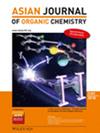ZrO2上的超小Fe3O4纳米颗粒作为CO2加氢制低烯烃催化剂
IF 2.8
4区 化学
Q1 CHEMISTRY, ORGANIC
引用次数: 0
摘要
有机合成为将大气中大量有害的二氧化碳(CO2)转化为更可持续的碳源提供了重要机会。为了减少碳足迹,我们探索了使用由zro2负载的碱金属促进的超顺磁性氧化铁纳米颗粒(SPIONs;Fe3O4)。这些催化剂的特点是制备简单;我们采用了一种具有成本效益的干混合方法来制备一系列在ZrO2上负载的碱金属掺杂SPIONs。结果表明,与其他形式相比,Fe3O4与ZrO2之间的强相互作用增强了CO2加氢性能。在最佳条件下-使用气体每小时空间速度(GHSV)为4500 mL/h/gcat。当催化剂的进料比为H2:CO2= 3:1时,该催化剂在30 bar和375℃条件下对轻烯烃(C2-4 =)具有较高的选择性,并在ZrO2上负载30 wt%的Fe3O4和2 wt%的K促进剂,实现了22%以上的CO2转化率。我们还研究了几个变量,包括碱金属浓度、铁含量、反应条件和催化剂在96小时内的稳定性。本文章由计算机程序翻译,如有差异,请以英文原文为准。

Ultrasmall Fe3O4 Nanoparticles on ZrO2 as Catalysts for CO2 Hydrogenation to Lower Olefins
Organic synthesis presents significant opportunities for converting the abundant and hazardous carbon dioxide (CO2) in the atmosphere into a more sustainable carbon source. To reduce the carbon footprint, we explored the direct hydrogenation of CO2 to lower (C2‐4=) olefins using various catalysts composed of ZrO2‐supported alkali‐metal‐promoted superparamagnetic iron oxide nanoparticles (SPIONs; Fe3O4). These catalysts are notable for their straightforward preparation; we employed a cost‐effective dry‐mixing method to create a range of alkali metal‐doped SPIONs supported on ZrO2. Results showed that the strong interactions between Fe3O4 and the ZrO2 support enhanced CO2 hydrogenation performance compared to other forms.. Under optimal conditions – using a gas hourly space velocity (GHSV) of 4500 mL/h/gcat. and a feed ratio of H2:CO2=3 : 1 – this catalyst achieved over 22 % CO2 conversion and high selectivity for light (C2–4=) olefins at 30 bar and 375 °C, with 30 wt% Fe3O4 loading on ZrO2 and 2 wt% K promoter. We also investigated several variables, including alkali metal concentration, iron content, reaction conditions, and catalyst stability over 96 hours.
求助全文
通过发布文献求助,成功后即可免费获取论文全文。
去求助
来源期刊

Asian Journal of Organic Chemistry
CHEMISTRY, ORGANIC-
CiteScore
4.70
自引率
3.70%
发文量
372
期刊介绍:
Organic chemistry is the fundamental science that stands at the heart of chemistry, biology, and materials science. Research in these areas is vigorous and truly international, with three major regions making almost equal contributions: America, Europe and Asia. Asia now has its own top international organic chemistry journal—the Asian Journal of Organic Chemistry (AsianJOC)
The AsianJOC is designed to be a top-ranked international research journal and publishes primary research as well as critical secondary information from authors across the world. The journal covers organic chemistry in its entirety. Authors and readers come from academia, the chemical industry, and government laboratories.
 求助内容:
求助内容: 应助结果提醒方式:
应助结果提醒方式:


